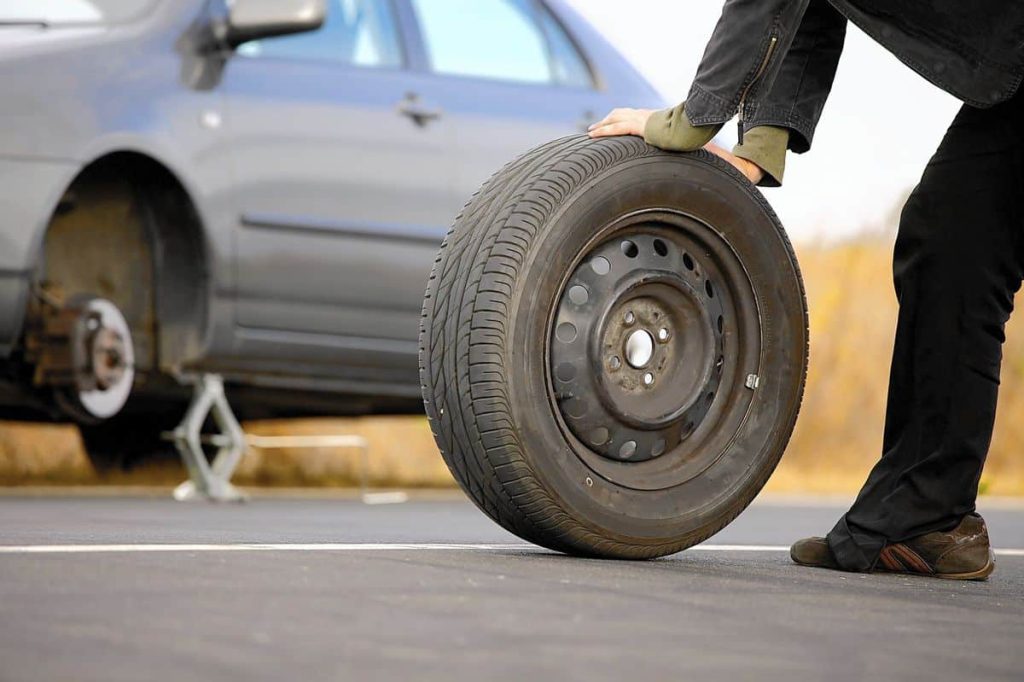Getting a flat tire is pretty much a frustrating experience, but then, having to drive on a spare tire to find an auto repair shop is another challenge. If you’re lucky, the tire shop is just nearby, or else, you’ll have to put out the question: “How long can you drive on a spare tire?”
We all know a spare tire is just a temporary saver for a flat tire along the road. Temporary tires often have either a shorter lifespan comparing to regular tires, or a less durable construction. It is not meant to completely replace as a full-size tire.
Different cars will have different kinds of spare tire, which affects differently on your drive time. Thus, back to the previous question, the answer given by professionals is that it really depends on your spare tire type.

How long can you drive on a spare tire?
Full-Size Spares
Since the start, cars were usually equipped with a full-size spare. Until this day, there are many older cars still have this type of spares, even with a SUV or other large vehicle.
It will be fortunate if the full-size spare given is the same type and size with the ones used in your vehicle. You can drive normally until it wears out. However, you still have to check it thoroughly before use for air pressure, and any cracks or holes, especially if the spare tire hadn’t been used for years.
On the other hand, a more common case is that the spare tire doesn’t match with the current ones that are in use. Thus, the size and specification are also different, so are the tread pattern and rubber compound, even if the tires look similar.
So even if the full-size spares give you that secure feeling, you should only drive on it for the recommended mileage of maximum 70 miles, and with the speed of maximum 50 miles per hour. More than that limit distance, you should already have your tires changed or repaired.
Donuts/ Space-savers
Over the years of car manufacturing, brands started to replace the vehicle with a space-saver spare tire, instead of a full-size spare. They realized the full-sized doesn’t really a good option for it isn’t used that frequently.
These space-saver spares, as known as “donuts”, are smaller and lighter in size and weight. Thus, they are both easier for installing and more compact for storing. That’s where the name “space-saver” came from.
However, to make it smaller (and cheaper in some cases), there are some important features needed to be taken out, especially stability and durability. This type of spare tire has little tread, so it is more prone to damages and limited in both speed and lifespan.
Thus, in this case, when it comes to the question “how long can you drive on a spare tire?”, it is pretty limited. A recommended distance is maximum 70 miles with speed of no more than 50 miles per hour, so you should really try to get to the tire shop as soon as possible.
A Run-Flat Tire
Coming across the expensive full-size tires and the undeveloped donuts, run-flat tires are becoming more and more popular in car manufacturing. This spare tire type are most likely to be seen in MINI or BMW recent models.
As its special design, run-flat tire is perfect for anyone who doesn’t like to add more weight to their cars, as well as who aren’t fans of changing to a spare tire. You can just have it patched if it ever gets punctured.
The biggest benefit of this type is how long can you drive on a spare tire, it can be up to 100 miles. Run-flat tires are built to withstand road hazards and even punctures. They are tough, but not built to use indefinitely. You still need to have it changed after the limit distance.
However, this kind of tire is pretty costly, sometimes more than full-size spares.
Frequently Asked Questions
u003cstrongu003eHow fast can you drive on a spare tire?u003c/strongu003e
u003cstrongu003eAnswer: u003c/strongu003eIt is highly recommended to keep the speed to maximum 50 MPH (miles per hour). You should really lower your speed while driving on a spare tire as they aren’t meant to be driven as a regular tire.u003cbru003eKnow your limit, keep the car straight as much as possible and stay in the low lane.
u003cstrongu003eHow can I know if my spare tire is in good condition?u003c/strongu003e
u003cstrongu003eAnswer: u003c/strongu003eHere are some steps you should do to make sure that your spare tire is in good condition:u003cbru003e- Visual inspection: Visually check around the tires if there is any cracks in the sidewalls or between tread blocks. If your tire has deep cracks that can allow a penny to catch on, it is totally not safe to use. There might be chances of blow out.u003cbru003e- Make sure the air pressure is correct to use: Look for the specification and use a pressure gauge to check the actual pressure of the tire. Then compare the two and if it’s below the specifications, you should re-inflate them.u003cbru003e- Check on the tread depth: There is a high chance of a spare tire replaced a few times if you bought a second-hand vehicle. The spares might have been replaced to a much lesser quality. Thus, if you see them worn out beyond 2/32 of an inch of the remaining tread, it’s time to have it replaced.
u003cstrongu003eWhile inspecting a full-size spare, what is the good-to-go air pressure?u003c/strongu003e
In most cases, the ideal air pressure level is at 60psi. You should check the pressure occasionally, to make sure your car can work at their best.
Final words
A spare tire is always the best saver in case of flat tires along the road. However, regardless of the spare tire types, you should always make sure to keep the speed of 50MPH to drive maximum to 70 miles as recommended, before having it repaired. Don’t risk your car trying to save the expenses.